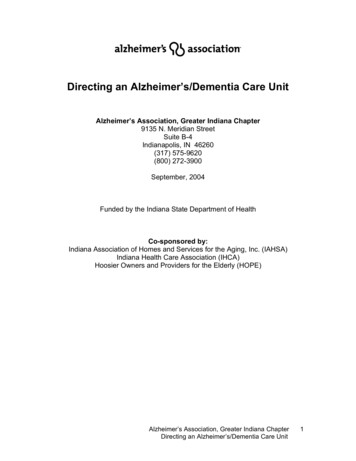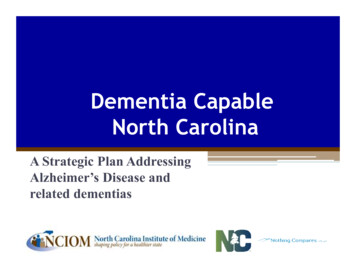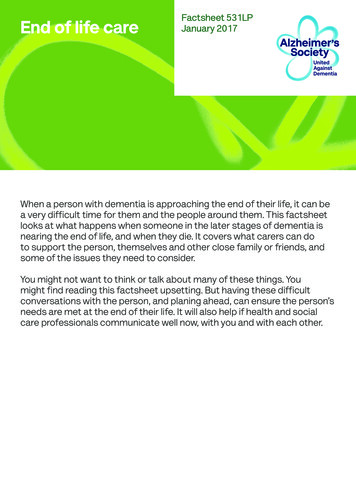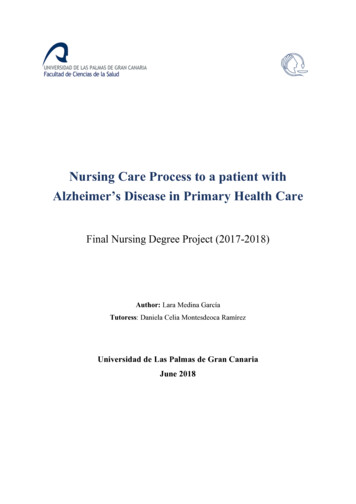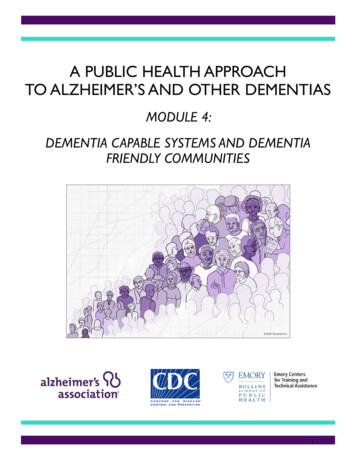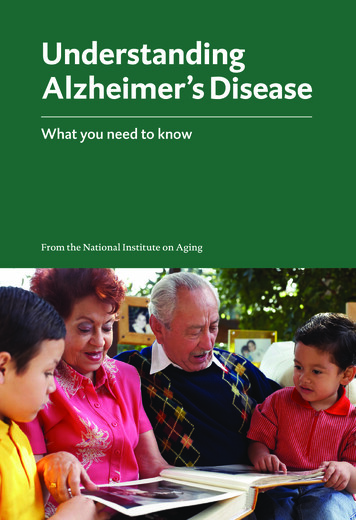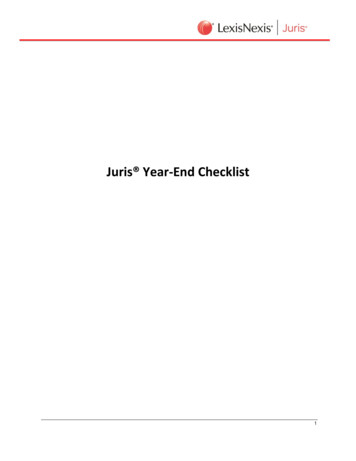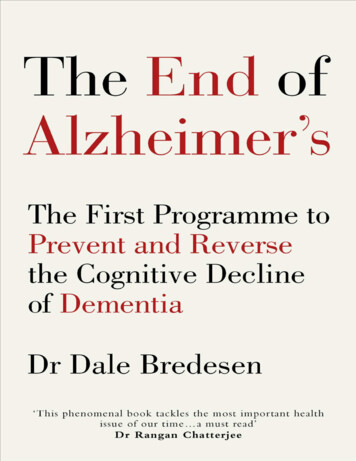
Transcription
ContentsCoverAbout the BookAbout the AuthorPraiseTitle PageDedicationPart One:The Alzheimer’s Solution1. Disrupting Dementia2. Patient Zero3. How Does It Feel to Come Back from Dementia?4. How to Give Yourself Alzheimer’s: A PrimerPart Two:Deconstructing Alzheimer’s5. Wit’s End: From Bedside to Bench and Back6. The God Gene and the Three Types of Alzheimer’s DiseasePart Three:Evaluation and Personalized Therapeutics7. The “Cognoscopy”—Where Do You Stand?8. ReCODE: Reversing Cognitive Decline9. Success and the Social Network: Two People’s Daily RoutinesPart Four:Maximizing Success10. Putting It All Together: You Can Do It11. This Is Not Easy—Workarounds and Crutches12. Resistance to Change: Machiavelli Meets t
About the BookThe first proven plan to reverse Alzheimer’s Disease.In The End of Alzheimer’s Dr Dale Bredesen offers real hope to anyonelooking to prevent and even reverse Alzheimer’s Disease and the cognitivedecline of dementia.Dr Bredesen reveals the 36 affecting metabolic factors and outlines a provenprogramme to rebalance them, which patients can follow with the help of ahealthcare professional. There are also general lifestyle and dietary changesal readers can adopt to improve cognitive health. Rewrites the science of Alzheimer’s Disease Step-by-step advice to follow with your doctor The first major breakthrough to stop Alzheimer’s in its tracks
About the AuthorDale Bredesen, MD, is internationally recognized as an expert in themechanisms of neurodegenerative diseases, such as Alzheimer’s disease. Heis Professor of Neurology at the University of California, Los Angeles.
Praise for The End of Alzheimer’s“The End of Alzheimer’s is a monumental work. Dr. Bredesen completely recontextualizes this devastating condition away from a mysterious andunsolvable process to one that is both preventable and, yes, reversible.”—DAVID PERLMUTTER, MD, AUTHOR OF THE #1 New York Times BESTSELLERSGrain Brain AND Brain Maker“The End of Alzheimer’s is a masterful, authoritative, and ultimately hopefulpatient guide that will help you prevent and reverse Alzheimer’s disease,whether you have the ApoE4 gene or not. My patients fear Alzheimer’s morethan any other diagnosis. This is the book to transmute fear into action.”—SARA GOTTFRIED, MD, AUTHOR OF THE New York Times BESTSELLERYounger“Dr. Dale Bredesen is a world-class neuroscientist-neurologist who throughhis innovative and exacting research has discovered a safe and effectiveapproach to the prevention and treatment of Alzheimer’s disease that willrevolutionize the way we think about the disease.”—JEFFREY BLAND, PHD, FOUNDER OF THE INSTITUTE FOR FUNCTIONALMEDICINE, THE CLEVELAND CLINIC“Dr. Bredesen has provided enormous hope for the heretofore intractableclinical problem of Alzheimer’s. Bredesen’s early studies suggest that thisapproach can halt and in many cases reverse early Alzheimer’s.”—LEROY HOOD, MD, PHD, AWARDED THE NATIONAL MEDAL OF SCIENCE,PRESENTED BY PRESIDENT BARACK OBAMA IN 2011, AND FOUNDER OF THEINSTITUTE FOR SYSTEMS BIOLOGY“Every citizen and medical professional interested in the brain and its healthshould read this seminal book. It should provide much of the basis for a truerevolution in brain health medicine.”—MICHAEL MERZENICH, PHD, WINNER OF THE 2016 KAVLI PRIZE INNEUROSCIENCE“A must-read for anyone wondering what can be done for this dread disease,
whether for themselves, a loved one, or a patient.”—NATHAN PRICE, PHD, PROFESSOR AND ASSOCIATE DIRECTOR OF THE INSTITUTEFOR SYSTEMS BIOLOGY“Having spent several years implementing many of Dr. Bredesen’s insights inmy patients, I can assure you that following his advice can save yourself,your loved ones, and your friends from suffering from this preventable andreversible curse.”—STEVEN GUNDRY, MD, MEDICAL DIRECTOR OF THE INTERNATIONAL HEARTAND LUNG INSTITUTE AND AUTHOR OF THE New York Times BESTSELLER ThePlant Paradox“This book represents a major turning point in our approach to Alzheimer’sdisease. For the first time ever, patients and families affected by Alzheimer’s—as well as those at high risk for this devastating disease—truly have areason to be hopeful.”—CHRIS KRESSER, MS, LAC, AUTHOR OF THE New York Times BESTSELLER ThePaleo Cure“The End of Alzheimer’s offers a new beginning in medicine. Dr. Bredesentranslates the knowledge of science to the wisdom that helps to heal ourpeople and provide a vision for the end of Alzheimer’s.”—PATRICK HANAWAY, MD, FOUNDING MEDICAL DIRECTOR AND DIRECTOR OFRESEARCH, THE CENTER FOR FUNCTIONAL MEDICINE, THE CLEVELAND CLINIC“An experimental program that some patients say has literally reversed theirsymptoms and allowed them to live a normal life.”—MARIA SHRIVER, APPEARING ON THE Today SHOW“The End of Alzheimer’s, for the first time, synthesizes the latest science intoa practical plan that can reverse Alzheimer’s and dramatically improve brainhealth and function. If you have a brain, read this book.”—MARK HYMAN, MD, DIRECTOR OF THE CENTER FOR FUNCTIONAL MEDICINE,THE CLEVELAND CLINIC, AND AUTHOR OF THE #1 New York Times BESTSELLEREat Fat, Get Thin“The End of Alzheimer’s is a phenomenal book. Dr. Dale Bredesen’s research
is some of the most exciting work that I have seen in years and tackles themost important health issue of our time. This helps us understand thiscomplex and devastating condition but is also the roadmap to prevent it in thefirst place. It is a must-read book. By tackling arguably the most importantdisease of our age, Dr. Dale Bredesen is actually changing the way we look atall chronic disease. This is a masterpiece.”—RANGAN CHATTERJEE, MBCHB, BSC (HONS), MRCP, MRCGP
This book is dedicated to my wife,Dr. Aida Lasheen Bredesen—a superb and caring physician who introduced me to the world offunctional and integrative medicine, and who has taught me more than anyone about this criticalfield—and to our two beloved daughters, Tara and Tess.
PART ONEThe Alzheimer’s Solution
CHAPTER 1Disrupting DementiaYou never change things by fighting the existing reality. To changesomething, build a new model that makes the existing model obsolete.—R. BUCKMINSTER FULLERto escape the drumbeat of grim news about Alzheimer’sdisease: that it is incurable and largely untreatable, that there is no reliableway to prevent it, and that the disease has for decades beaten the world’s bestneuroscientists. Despite the billions and billions of dollars spent bygovernment agencies, pharmaceutical companies, and biotechnology wizardsto invent and test drugs for Alzheimer’s, 99.6 percent of what we have comeup with have been abysmal failures, not even making it out of the testingphase. And if you think there is hope in the 0.4 percent of discoveries thathave reached the market—after all, we need only one Alzheimer’s drug if it’seffective, right?—think again. As the Alzheimer’s Association puts it in ableak reality check, “A genuinely new Alzheimer’s drug has not beenapproved since 2003, and the currently approved Alzheimer’s medicationsare ineffective in stopping or slowing the course of the disease.” Although thefour available Alzheimer’s drugs “may help lessen symptoms, such asmemory loss and confusion,” they do so only “for a limited time.”Maybe you’re racking your memory to recall when you last read about theFood and Drug Administration approving a new Alzheimer’s drug. Don’tworry if you can’t: of 244 experimental Alzheimer’s drugs tested from 2000to 2010, exactly one—memantine—was approved, in 2003. And as I’llexplain below, its effects are modest at best.As I said, grim. No wonder a diagnosis of Alzheimer’s disease is the lastthing anyone wants to hear. One man whose wife was in the midst of the longgoodbye of Alzheimer’s shook his head, bereft, and said, “We are toldrepeatedly that drugs are being developed that will slow the decline—butwhy would anyone do that? I can tell you, living with this every day—that isthe last thing you would want.”IT IS IMPOSSIBLE
Alzheimer’s disease has become part of the zeitgeist. In news articles andblogs and podcasts, on the radio and television and in films both documentaryand fictional, we read and hear story after story about Alzheimer’s disease.Sadly, all end tragically. We fear Alzheimer’s as we fear no other disease.There are at least two reasons for that.First, it is the only one—let me repeat that: the only one—of the nation’sten most common causes of death for which there is no effective treatment.And by “effective,” I am setting the bar pretty low. If we had a drug or otherintervention that made people with Alzheimer’s disease even a little better,never mind curing the disease, I’d sing its praises to the rooftops. So wouldeveryone who has a loved one with Alzheimer’s, everyone at risk forAlzheimer’s, and of course everyone who has already developedAlzheimer’s. But no such drug exists. We don’t even have a treatment tokeep people with subjective cognitive impairment or mild cognitiveimpairment (two conditions that often precede Alzheimer’s disease) fromgoing on to develop full-blown Alzheimer’s.Incredibly, given the astounding progress in other areas of medicine overthe last twenty years—think cancer or HIV/AIDS or cystic fibrosis orcardiovascular disease—as I write this in 2017 not only is there no cure forAlzheimer’s disease, there is not even anything that reliably prevents orslows Alzheimer’s disease. You know how critics make fun of TV afternoonspecials and Lifetime movies about angelic children or saintly mothers andfathers who bravely battled cancer and, with the aid of the latest miracle drug,are restored to perfect health before the final credits roll? Schmaltzy, sure.We in the Alzheimer’s field would happily settle for schmaltzy if it wereeven remotely plausible to depict a happy ending to this disease.The second reason Alzheimer’s disease inspires such dread is because it’snot “only” fatal. Lots of diseases are fatal. As the old joke has it, life is fatal.Alzheimer’s is worse than fatal. For years and sometimes decades before itopens the door to the grim reaper, Alzheimer’s disease robs its victims oftheir very humanity and terrorizes their families. Their memories, theircapacity for thought, their ability to live full and independent lives—all gone,in a grim and unrelenting descent into a mental abyss where they no longerknow their loved ones, their past, the world, or themselves.The linguistics professor who is the heartbreaking protagonist of the 2014movie Still Alice carries a DNA mutation that causes Alzheimer’s disease to
develop by middle age, discovered in 1995. You’ve probably read about thegreat strides that cancer biologists have made by discovering genesassociated with tumors and crafting drugs based on them. With Alzheimer’sdisease? That 1995 discovery has not led to the development of a singleAlzheimer’s drug.This awful disease stands out for one additional reason. The last fifty yearshave brought triumph after triumph in molecular biology and neuroscience.Biologists have untangled the immensely complex pathways that lead tocancer and have figured out how to block many of them. We have mappedout the chemical and electrical processes in the brain that underlie thoughtsand feelings, developing effective, if imperfect, drugs for depression andschizophrenia, for anxiety and bipolar disorder. Sure, there’s a lot left to belearned, and a lot of improvement needed for the compounds in ourpharmacopoeias. But in virtually every other disease there is a strong sensethat research is on the right track, that the basics are understood, that althoughnature will keep throwing curve balls at us, she has revealed to us thefundamental rules of the game. Not so with Alzheimer’s.In this disease, it’s as if nature handed us a rule book written indisappearing ink and edited by evil gremlins who rewrite entire sectionswhen our backs are turned. What I mean is this: seemingly rock-solidevidence from lab rodents suggested that Alzheimer’s disease is caused bythe accumulation in the brain of sticky synapse-destroying plaques made of apiece of a protein called amyloid-beta. Those lab studies indicated thatamyloid-beta is formed in the brain by a series of steps, and that eitherintervening in those steps or destroying amyloid-betafn1 plaques would be aneffective way to treat and even prevent Alzheimer’s disease. Since the 1980smost neurobiologists have treated this basic idea, called the amyloidhypothesis, as dogma. It has won its developers multimillion-dollar prizes,countless accolades, and prestigious academic positions. It has had a hugeinfluence on which Alzheimer’s papers get published in top medical journals(hint: preference goes to those that toe the amyloid line) and what studies getfunded by the U.S. National Institutes of Health, the nation’s chief source ofsupport for biomedical research (ditto).But here’s the thing: when drug companies tested compounds that arebased on any piece of the amyloid hypothesis, the results have ranged from
frustrating to bewildering. In clinical trials, human brains did not respond tothese compounds the way the rule book said they should. It would be onething if the compounds failed to do what they were designed to do. Thatwasn’t what happened. In many cases the compounds (usually, antibodiesthat bind to amyloid in an attempt to remove it) did a great job at removingamyloid plaques. Or if the compound was designed to block the enzymeneeded to produce amyloid, it did a great job at that. The experimentalcompounds did precisely what their inventors intended, following theamyloid rule book, but patients either got no better or, incredibly, got worse.What keeps emerging from these clinical trials (which, by the way, often costupward of 50 million each) is exactly the opposite of what all the test-tuberesearch based on the amyloid hypothesis and all the mouse models of theamyloid hypothesis and all the theories of the amyloid hypothesis predicted.Targeting amyloid was supposed to be the golden ticket to curingAlzheimer’s. It wasn’t.It’s as if our space rockets exploded on the launchpad every single time.Something is enormously wrong here.Just as tragic as the blinkered adherence to the amyloid hypothesis ismainstream medicine’s assumption that Alzheimer’s is a single disease. Assuch, it is typically treated with donepezil (Aricept) and/or memantine(Namenda). I know I said that there is currently no treatment for Alzheimer’sdisease, so let me explain.Aricept is what’s called a cholinesterase inhibitorfn2: it keeps a particularenzyme (cholinesterase) from destroying acetylcholine, a type of brainchemical called a neurotransmitter. Neurotransmitters carry signals from oneneuron to another, which is how we think, remember, feel, and move, and sois important for memory and overall brain function. The rationale is simple:in Alzheimer’s disease, there is a reduction in acetylcholine. Therefore, if youblock the enzyme (cholinesterase) that breaks down acetylcholine, more willremain in your synapses. Then, even as Alzheimer’s is ravaging the brain, thesynapses might remain functional a little while longer.To a modest extent, this rationale does work, but there are importantcaveats. First, blocking the breakdown of acetylcholine does not affect thecause or progression of Alzheimer’s disease. The disease therefore stillprogresses. Second, the brain often responds to inhibition of cholinesterase as
you might expect: by making more cholinesterase. That obviously limits thedrugs’ efficacy (and can become a real problem if the drug is stoppedsuddenly). Third, like all drugs, cholinesterase inhibitors have side effects;they include diarrhea, nausea and vomiting, headache, joint pain, drowsiness,loss of appetite, and bradycardia (slowed heart rate).As for memantine, it too acts on brain chemicals and molecules that havelittle to do with fundamental Alzheimer’s pathophysiology, but, like Aricept,might reduce (or even delay) the symptoms of the disease, at least for a time.It is typically used later in the disease, but may be used in combination with acholinesterase inhibitor. Memantine inhibits the transmission of brain signalsfrom one neuron to the next via the neurotransmitter glutamate. Inhibitingthat transmission reduces what’s called glutamate’s excitotoxic effect,meaning the toxic effect associated with neuronal activation. Unfortunately,memantine may also inhibit the very neurotransmission critical to memoryformation, and so may initially impair cognitive function.Most important, neither cholinesterase inhibitors nor memantine gets at theunderlying causes of Alzheimer’s or stops the disease from worsening—andthey certainly do not cure it.All of that is bad enough, but there is a more fundamental problem.Alzheimer’s is not a single disease. Sure, the symptoms might make it looklike it is, but as I explain in chapter 6, we discovered that there are three mainsubtypes of Alzheimer’s. Our research on the different biochemical profilesof people with Alzheimer’s has made it clear that these three readilydistinguishable subtypes are each driven by different biochemical processes.Each one requires a different treatment. Treating them all the same way is asnaive as treating every infection with the same antibiotic.It’s bad enough that Alzheimer’s disease has, for more than thirty years,defeated the greatest minds in neuroscience and medicine. (I’m not countingthe seventy-plus years between when the disease was named and when theamyloid hypothesis emerged; much less research was done on Alzheimer’sdisease in those decades.) Anyone who pays attention can see that we’reusing the wrong approach. In particular, the idea of identifying the cause ofthe amyloid production, removing that, and then removing the amyloid, hasnot been tested.If you have a high risk of developing Alzheimer’s because of the genesyou carry, if you have already developed it, or if you have a loved one who
has, you therefore have every right to be very upset about this situation.No wonder we have come to fear Alzheimer’s disease as omnipotent. Ashopeless. As impervious to any and all treatments.Until now.Let me say this as clearly as I can: Alzheimer’s disease can be prevented,and in many cases its associated cognitive decline can be reversed. For thatis precisely what my colleagues and I have shown in peer-reviewed studies inleading medical journals—studies that, for the first time, describe exactly thisremarkable result in patients. Yes, I know it flouts decades of conventionalwisdom to claim that cognitive decline can be reversed, that there arehundreds of patients who have done just that, and that there are steps we canall take now to prevent the cognitive decline that experts have long believedto be unavoidable and irreversible. These are bold claims deserving ofhealthy skepticism. I expect you to exercise that skepticism as you read aboutthe three decades of research in my lab, which culminated in the firstreversals of cognitive decline in early Alzheimer’s disease and its precursors,MCI (mild cognitive impairment) and SCI (subjective cognitive impairment).I expect you to exercise that skepticism as you read the stories of thesepatients, patients who climbed out of the abyss of cognitive decline. I expectyou to exercise that skepticism as you read about the personalized therapeuticprograms we developed to enable everyone to prevent cognitive impairmentand, if they are already showing signs of it, to stop mental decline in its tracksand restore their ability to remember, to think, and to once again live acognitively healthy life.But if the results I describe overcome your skepticism, then please openyour mind and consider changing your life—not only if you have alreadybegun the slide into cognitive decline, but even if you haven’t. Needless tosay, the people who will find this book most immediately and directly lifechanging are those whose memory and cognition are already suffering (andtheir family members and caretakers). By following the protocol I describe,those with cognitive impairment that is not yet Alzheimer’s disease, as wellas those who are already in the grip of Alzheimer’s, can not only halt butoften actually reverse the cognitive decline they have already suffered. Forthose so stricken, progression to severe dementia has until now beeninevitable, with nothing but bad news from every expert. The antiAlzheimer’s protocol my colleagues and I developed consigns that bleak
dogma to the dustbin of history.There is a second, very specific group for whom this book can mean thedifference between the grim future they have probably been told to expectand a future filled with health and joy. These are the people who carry a genevariant (allele) called ApoE4 (ApoE is short for apolipoprotein E; anapolipoprotein is a protein that carries lipids—i.e., fats). ApoE4 is thestrongest known genetic risk factorfn3 for Alzheimer’s disease. Carrying oneApoE4 (that is, inherited from one parent) increases your life-time risk ofAlzheimer’s to 30 percent, while carrying two copies (inheriting copies fromboth parents) increases it to well over 50 percent (from 50 to 90 percent,depending on which study you read). That compares to a risk of only about 9percent in people who carry zero copies of this allele.The vast majority of ApoE4 carriers don’t know about this potentialticking time bomb in their DNA, and typically find out only after the onset ofsymptoms of Alzheimer’s disease spur them to undergo genetic testing. It iscertainly understandable that, as long as there is no prevention or treatmentfor Alzheimer’s, most people would not want to know their ApoE status. Infact, when Nobel laureate Dr. James Watson (codiscoverer of the DNAdouble helix) had his genome sequenced in 2007, he said he did not wish tobe told whether he carried ApoE4; why expose yourself to devastating newsif there’s nothing you can do about it? However, now that there is a programthat can reduce the risk of Alzheimer’s, even in those carrying ApoE4,dramatic reductions in the prevalence of dementia could be achieved if morepeople underwent genetic testing to determine their ApoE status and initiateda preventive program long before any symptoms appeared. It is my ferventhope that this is exactly what will happen, and that ApoE4 carriers inparticular learn from this book that their situation is not hopeless: you too cantake steps to prevent Alzheimer’s disease or reverse cognitive decline.There is a perhaps less obvious group, for whom I believe this book can belife-changing: everyone past the age of 40. The number one concern ofindividuals as we age (and yes, when we talk about brain aging, the downhillslide begins at about 40) is the loss of our cognitive abilities. For it is thoseabilities—to read a letter from a loved one and comprehend it; to watch amovie or read a book and follow the plot; to observe the people in our livesand understand them; to perceive the events around us and maintain a sense
of our place in the world; to perform the basic functions of daily life so weare not mere sacks of protoplasm dependent on others to feed, dress, move,and bathe us; to remember the events of our life and the people who havebeen precious to it—that define us as human. When they go, so does our veryidentity as someone with a meaningful life. To all of you lucky enough tohave avoided even a hint of these losses even as you are acutely aware thatthey may be lurking in your future, my message is this: take a deep breathand realize that cognitive decline is—at least for most of us and, especially,early in its course—addressable. Despite what you may have been told, it isnot hopeless or irreversible. To the contrary. For the first time, hope andAlzheimer’s have come together.And the reason for that is one fundamental discovery: Alzheimer’s“disease” is not the result of the brain doing something it isn’t supposed todo, the way cancer is the result of cells proliferating out of control or heartdisease is the result of blood vessels getting clogged with atheroscleroticplaque. Alzheimer’s arises from an intrinsic and healthy downsizing programfor your brain’s extensive synaptic network. But it is a program that has runamok, sort of the way Mickey Mouse’s efforts to get enchanted brooms tocarry buckets of water for him in “The Sorcerer’s Apprentice” segment of the1940 classic Fantasia eventually lead to the brooms running amok. InAlzheimer’s, an otherwise normal brain-housekeeping process has gonehaywire.not a scientific tome—though I include the scientific evidencethat supports my conclusions—but instead a practical, easy-to-use, step-bystep manual for preventing and reversing the cognitive decline of earlyAlzheimer’s disease or its precursors, mild cognitive impairment andsubjective cognitive impairment, and for sustaining that improvement. It isalso a guidebook by which the 75 million Americans who carry the ApoE4gene can escape the fate written in their DNA. The protocol for achieving thisled to the first-ever scientific publication of a study, in 2014,fn4 reporting thereversal of cognitive decline in patients—nine out of ten of them—withAlzheimer’s disease or its precursors, thanks to a sophisticated personalizedprotocol based on our decades of research on the neurobiology ofAlzheimer’s disease. Called ReCODE,fn5 for reversal of cognitive decline,the protocol not only achieved the reversal of cognitive decline inTHIS BOOK IS
Alzheimer’s disease and pre-Alzheimer’s that no one thought possible; it alsoallowed patients to sustain that improvement. The very first patient treatedwith what is now the ReCODE protocol is, as I write this, five years into thetreatment, and at 73 remains cognitively healthy, traveling the world andworking full-time. Our extensive subsequent work, with hundreds of patients,proves that she is far from unique.After publication of the 2014 study, we received many thousands ofemails, phone calls, and visits from physicians and other practitioners,potential patients, and family members from all over the United States, theUK, Australia, Asia, Europe, and South America, wanting to learn moreabout the successful protocol. The journal that had published the study iscalled Aging, and the staff called to inform us that, of the tens of thousands ofscientific papers the journal had published over the years, ours had scored inthe top couple—and thus in the 99.99th percentile—in the system of metricsthat gauges impact and interest. Although in that initial scientific paper I didnot include a detailed step-by-step description of the protocol (scientificjournals have page limitations for each paper), in this book I do. I alsorecount how I developed ReCODE and explain its scientific basis. In theappendix, I list sources of the foods, supplements, and other components ofReCODE as well as links to physicians and other health-care practitionerswho are knowledgeable about it and can help you implement it in your ownlife—or in the life of a loved one.There is nothing more important than making a difference in the lives ofpatients, and that is what has driven me in the decades-long quest to find away to prevent and reverse Alzheimer’s disease. But if enough people adoptReCODE, they will be helping far more than themselves. BecauseAlzheimer’s disease strikes an estimated one in nine Americans 65 and older,or 5.2 million people as I write this, the aging of the baby boom generationthreatens to bring a tsunami of Alzheimer’s immense enough to bankruptMedicare and Medicaid and overwhelm the nation’s long-term care facilities—to say nothing of the toll it will take on tens of millions of families whoseloved ones are swallowed by this merciless disease. Globally, a projected 160million people will, by 2050, develop Alzheimer’s. That makes the need forprevention and treatment greater than ever. The hundreds of patients I haveseen battle back from cognitive decline—battle back despite the medicaldogma that such a recovery is impossible—have convinced me that the
prevention and treatment of Alzheimer’s is not some pie-in-the-sky fantasy.We know how to do it—now, today.That’s what I mean when I say that if enough people adopt ReCODE, theconsequences would ripple across the nation and the world, cutting medicalcosts by many billions of dollars a year, preventing Medicare’s bankruptcy,reducing the global burden of dementia, and enhancing longevity. All ofthese are feasible.Here, finally, is nothing less than the first good news about Alzheimer’sdisease. It is a chronicle of joy, of the blessing of getting your life back. Oneof the patients you shall read about said he has allowed himself to think aboutthe future once again when he talks to his grandchildren. Another said hermemory is better than it has been in thirty years. One musician’s wife said hisguitar playing has returned; the daughter of another said her mother, who hadbeen disappearing slowly each time the daughter returned from college, isonce again part of the family. What you read about here is the beginning of achanged world, the beginning of the end of Alzheimer’s disease.Here’s what’s ahead:Chapters 2 to 6 relate the scientific odyssey that led to ReCODE. Theydescribe the discoveries that form the scientific basis of the treatmentprotocol—what Alzheimer’s disease actually looks like “under the hood,”where it comes from, and why it is so common. These are the discoveries thatsupport the first effective approach to preventing cognitive decline,identifying the metabolic and other factors that increase your risk, andreversing cognitive decline if it has already begun. These are also thediscoveries that challenge the central dogma of Alzheimer’s: they showedthat this devastating disease is the result of a normal, healthy brain processthat has gone haywire. That is, the brain suffers some injury, infection, orother assault (I’ll explain t
Grain Brain AND Brain Maker “The End of Alzheimer’s is a masterful, authoritative, and ultimately hopeful patient guide that will help you prevent and reverse Alzheimer’s disease, whether you have the ApoE4 gene or not. My patients fear Alzheimer’s more than any other diagnosis. This is
